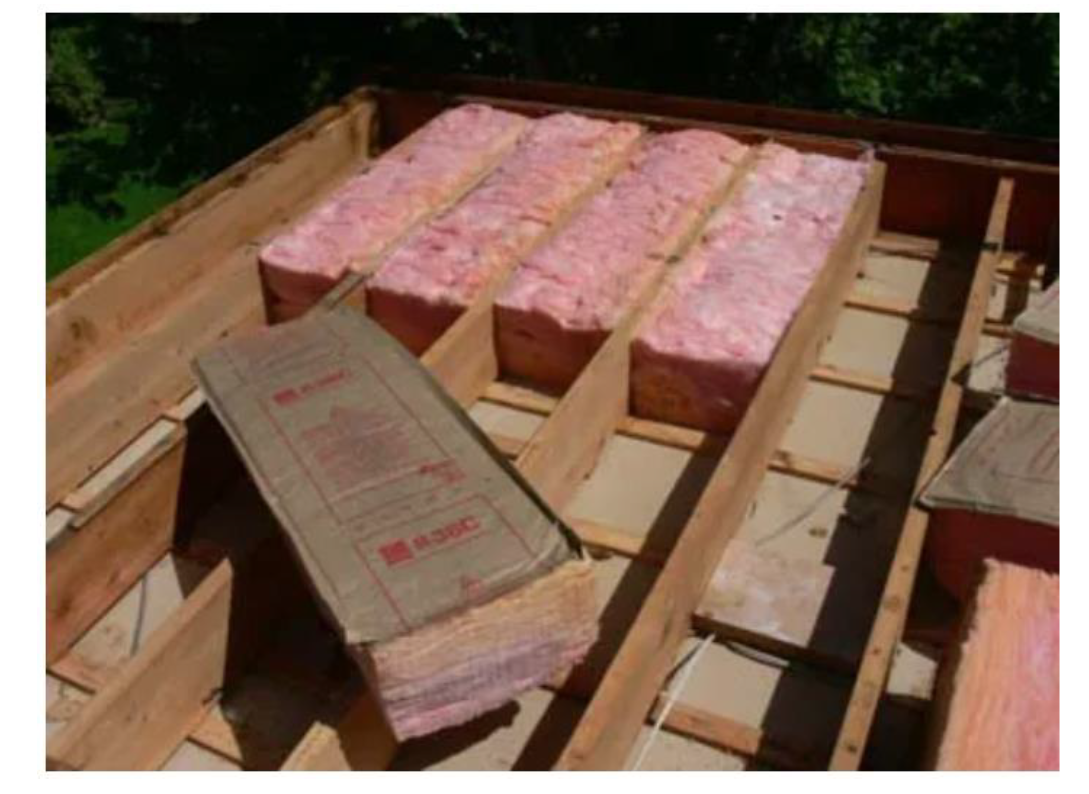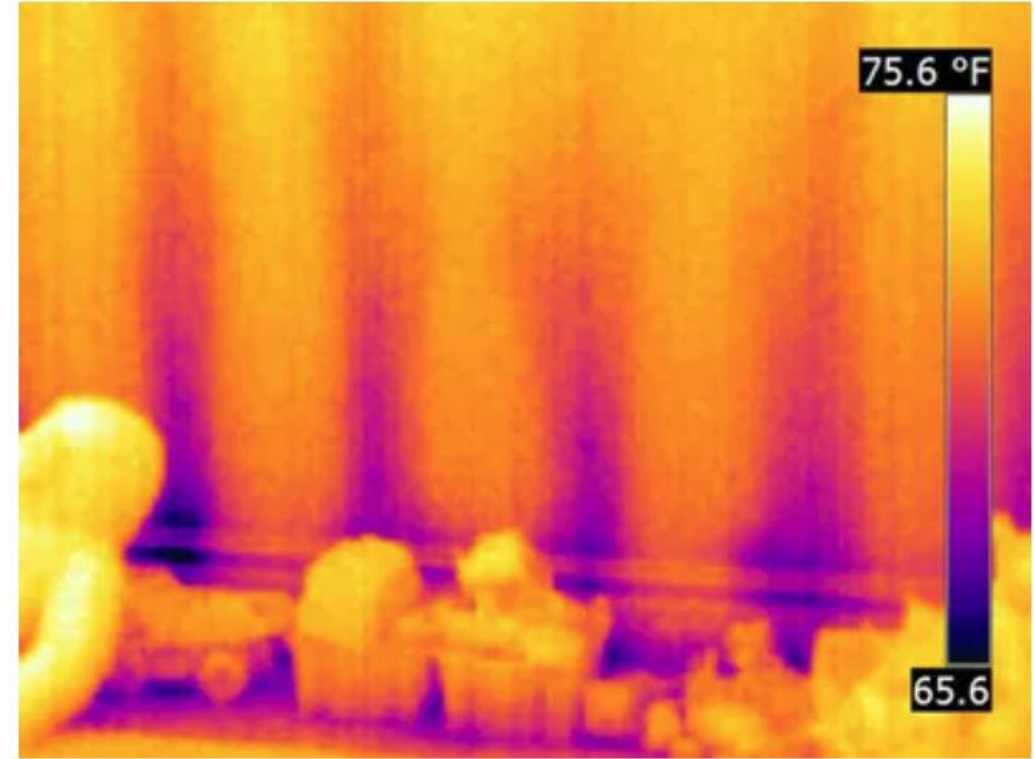Warm Roof vs Cold Roof. What’s the difference?

When it comes to insulating a flat roof, there are two options. Warm Roof vs Cold Roof. Understanding the distinction between these two types of roofs is essential for homeowners, builders, and anyone involved in roofing projects.
Knowing the differences can help you make informed decisions regarding insulation, energy efficiency, and overall comfort, whether you're planning to build a new roof or upgrade an existing one.
Keep reading if you need clarification on the difference between warm and cold roof insulation.
Cold Roof
A cold roof isn't as cold as the title suggests. In this technique, insulation is laid between the rafters, and since the only thing between the rafters is space, this is a relatively low-impact way to insulate your roof.

So why is it called a cold roof? Although most of the ceiling below is well insulated, the roof structure (rafters) is uninsulated, meaning the cold will conduct through the rafters and into the room down on a winter's day.
On a thermal imaging camera, you can spot where the rafters are situated by looking at the ceiling. This is because wooden rafters conduct heat much better than insulation, called thermal bridging.

Below is an example of thermal bridging on a wall. The darker purple marks are the timbers in the wall frame where the insulation isn't laid. This is the same principle as on a flat roof.
While a cold roof may be an easy option when first creating a flat roof, it can be very time-consuming if you're looking to insulate an existing one.
Insulating an existing flat roof requires ripping up any existing roof surface to enable you to lay the insulation in between; this also means that the roof surface has to be replaced or redone, adding to the job's complexity.
Advantages Of Cold Roofs
-
Energy Efficiency: Cold roofs minimise heat transfer, improving energy efficiency and reducing heating and cooling costs.
-
Moisture Management: Proper ventilation in cold roofs helps manage moisture, preventing condensation, mould growth, and structural damage.
-
Extended Roof Lifespan: Cold roof insulation and moisture management features contribute to prolonged roof durability.
-
Enhanced Comfort: Cold roofs maintain a consistent indoor temperature, reducing drafts and improving occupant comfort.
-
Environmentally Friendly: Cold Roof's energy efficiency reduces carbon footprint and greenhouse gas emissions.
-
Cost Savings: Though initial installation costs may be higher, cold roofs offer long-term savings through reduced energy bills and maintenance expenses.
-
Flexibility in Roofing Materials: Cold roofs are compatible with various roofing materials, allowing design flexibility and customisation.
-
Consideration: Local climate and building regulations should be considered when choosing a roofing system. Consulting professionals is recommended.
Warm Roof
A warm deck roof can be straightforward to install and offers higher thermal performance at the cost of a higher roof profile. Warm roof insulation tends to relate more to pitched roofs, which feature, as mentioned in the previous sentence, a higher profile.
In constructing a warm roof, the insulation sits on the rafters.

The warm roof insulation is installed on the existing surface instead of insulating between rafters. If the roof surface is still in good condition, you need only brush off any debris before securing insulation boards with adhesive and laying any flat roof covering on top.
Warm roof insulation ensures the entire roof structure is insulated, meaning a warm deck roof is more energy efficient than a cold roof.
Advantages of Warm Roof
-
Improved Energy Efficiency: Warm roofs prevent heat loss by placing insulation above the roof deck, leading to energy savings and lower heating costs.
-
Enhanced Thermal Performance: Continuous insulation minimises thermal bridging, maintains consistent indoor temperature, and provides a comfortable environment.
-
Condensation Prevention: Placing an insulation board above the roof deck reduces the risk of condensation on the underside, aided by a vapour barrier.
-
Reduced Roof Maintenance: Stable temperatures and minimised condensation stress and strain on roof components results in lower maintenance needs and longer lifespan.
-
Flexibility in Roof Design: Warm roofs allow usable space below the roof deck without extensive insulation modifications, enabling versatile building designs.
-
Improved Sound Insulation: Extra insulation in warm roofs reduces external noise, enhancing the indoor environment's quietness.
-
Prevents Ice Dam Formation: Warm roofs minimise heat loss, preventing snow from melting and the formation of damaging ice dams in cold climates.
The Breakdown - Warm Roof vs Cold Roof
When deciding what type of roof will suit your home, it is essential to know the comparison between a warm roof and a cold roof.
|
Feature |
Warm Roof |
Cold Roof |
|
Insulation location |
On top of the roof deck |
Between the rafters |
|
Thermal performance |
More energy efficient |
Less energy efficient |
|
Cost |
More expensive |
Less expensive |
|
Ease of installation |
Easier to install |
More difficult to install |
|
Ability to support plant growth |
Not possible |
Possible |
|
Ability to support pedestrian traffic |
Not possible |
Possible |
|
Risk of thermal bridging |
Lower risk |
Higher risk |
|
Overheating potential |
Higher risk |
Lower risk |
|
Vapour control layer |
Required |
Not required |
|
Moisture/interstitial condensation in the roof construction |
Less likely to occur |
More likely to occur |
|
Ventilation |
Required |
Not required |
|
Compatibility |
Compatible with most roofing materials |
Not compatible with some roofing materials |
Installation Process and Thermal Performance
Cold flat roof insulation requires more work, taking off old boards and replacing them and the roof surface. The thermal efficiency isn't as good as with warm roof insulation.
A warm deck roof is much easier to install and offers great thermal performance but adds height to the flat roof. As a result of the height difference, warm roofs cannot be used on balconies and flat roof extensions with doors leading onto the roof. In these cases, a cold roof is a preferable alternative to warm roof insulation.
Roof buildup depth
A cold roof primarily has insulation between rafters which results in a thinner roof buildup.
In contrast, a warm roof has insulation above the substrate, allowing for a deeper construction. This permits thicker insulation materials, improving thermal performance and reducing heat loss risk.
Vapour Control Layer (VCL)
In a cold roof, the vapour control layer (VCL) can be punctured where internal surfaces are fixed, compromising its effectiveness as a moisture barrier.
Conversely, the vapour control layer is securely bonded on top of the substrate layer in a warm roof, maintaining its integrity. However, mechanical fixings in the waterproofing layer can still compromise the VCL's effectiveness in preventing moisture penetration.
Moisture/Interstitial Condensation In The Roof Construction
The vapour control layer is usually put in when fixing internal finishes. Ventilation is recommended for cold roofs to manage potential moisture and condensation issues.
Warm roofs do not have moisture or condensation problems and are typically unventilated.
However, inadequate VCL installation or water ingress during construction can trap moisture, leading to insulation degradation and reduced U-Value performance.
Ventilation
Cold roofs require ventilation according to BS5250 standards, while warm tops are typically unventilated.
Ability To Support Pedestrian Traffic Or Heavy Load
In a cold roof, the roof covering is supported by a substrate directly below it. This substrate offers a solid base that supports roof plant installations, decking, or pedestrian access.
In contrast, in a warm roof system, the roof covering material is supported by insulation. However, insulation is prone to compression when subjected to heavy loads. This compression can cause damage to the waterproofing membrane, particularly when excessive weight or pressure is applied.
Compatibility
Cold roofs are compatible with all types of roof coverings. However, warm tops are suitable for most covers except fully supported metal roofing.
Frequently Asked Questions (FAQs)
Is a warm roof more expensive than a cold roof?
The cost of a warm roof is generally higher than a cold roof. A warm roof requires insulation to be installed above the roof deck, which adds to the material and labour costs. In contrast, a cold roof lacks insulation and is typically less expensive to construct.
Can you turn a cold roof into a warm roof?
Yes, converting a cold roof into a warm one is possible. This process involves adding insulation on or between the roof rafters to create a continuous thermal barrier. However, it can be a complex and costly retrofitting process requiring professional expertise and careful planning.
Do you need planning permission for a warm roof?
In most cases, installing a warm roof does not require planning permission. Since it is considered an improvement rather than an extension or alteration to the property's external appearance, it falls under permitted development rights. However, it's advisable to check with local authorities and consult building regulations to ensure compliance.
We offer a variety of high-quality roofing supplies and materials products across North London and Hertfordshire. You can shop directly online; if you prefer looking at the material in person, click on the store locator and find the nearest store.
Alternatively, you can message us at web.sales@jjroofing.co.uk or call 0333 700 1111
Our Top Videos.


How to install a Velux Integra Electric Roof Window (5 Parts)
In this five-part guide, we take you through the full installation of a Velux GGU Centre Pivot Integra Roof Window onto an...


How to install a Duratech Centre-Pivot Pine Roof Window
Once you begin unpackaging the window, you’ll find in the box the brackets, the handle and the fixings. And there will also be some instructions...
Ideas & Advice
How-tos, tutorials and videos


How and why to use or snap a chalk line
Chalk lines are the fastest way to mark straight guidelines on flat surfaces. They are used extensively in the building and construction industry to speedily and accurately ‘draw’ straight lines between two points. Chalk lines are inexpensive tools...


Skylight Blinds: A Guide To The Different Types
Like many household product, blinds for skylight windows come in all shapes, sizes, and materials. Some are designed with a tangible purpose in mind, while others are more for show. One thing’s for sure - buying any type of skylight blind...








